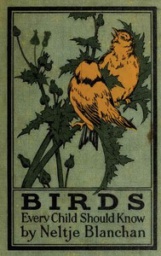

Birds Every Child Should Know (1907)
by Neltje Blanchan


See him feeding on the ground instead of on the striped and mottled tree trunks, where his black and white striped relatives are usually found, and you will realise that he wears brown clothes, finely barred, because they harmonise so perfectly with the brown earth. What does he find on the ground that keeps him there so much of the time? Look at the spot he has just flown from and you will doubtless find ants. These are chiefly his diet. Three thousand of them, for a single meal, he has been known to lick out of a hill with his long, round, extensile, sticky tongue. Evidently this lusty fellow needs no tonic. His tail, which is less rounded than his cousins', proves that he has little need to prop himself against tree trunks to pick out a dinner; and his curved bill, which is more of a pickaxe than a hammer, drill, or chisel, is little used as a carpenter's tool except when a nest is to be dug out of soft, decayed wood. Although he can beat a rolling tattoo in the spring, he has a variety of call notes for use the year through. Did you ever see the funny fellow spread his tail and dance when he goes courting? Flickers condescend to use old holes deserted by their relatives who possess better tools. You must have noticed all through these bird biographies that the structure and colouring of every bird are adapted to its kind of life, each member of the same family varying according to its habits. The kind of food a bird eats and its method of getting it, of course, bring about most, if not all, of the variations from the family type. Each is fitted for its own life, "even as you and I."🏁
Global Leaderboard
| # | Player | Time | Duration | Accuracy | WPM | pp | |
|---|---|---|---|---|---|---|---|
| 1 | |||||||
| 2 | |||||||
| 3 | |||||||
| 4 | |||||||
| 5 | |||||||
| 6 | |||||||
| 7 | |||||||
| 8 | |||||||
| 9 | |||||||
| 10 |


See him feeding on the ground instead of on the striped and mottled tree trunks, where his black and white striped relatives are usually found, and you will realise that he wears brown clothes, finely barred, because they harmonise so perfectly with the brown earth. What does he find on the ground that keeps him there so much of the time? Look at the spot he has just flown from and you will doubtless find ants. These are chiefly his diet. Three thousand of them, for a single meal, he has been known to lick out of a hill with his long, round, extensile, sticky tongue. Evidently this lusty fellow needs no tonic. His tail, which is less rounded than his cousins', proves that he has little need to prop himself against tree trunks to pick out a dinner; and his curved bill, which is more of a pickaxe than a hammer, drill, or chisel, is little used as a carpenter's tool except when a nest is to be dug out of soft, decayed wood. Although he can beat a rolling tattoo in the spring, he has a variety of call notes for use the year through. Did you ever see the funny fellow spread his tail and dance when he goes courting? Flickers condescend to use old holes deserted by their relatives who possess better tools. You must have noticed all through these bird biographies that the structure and colouring of every bird are adapted to its kind of life, each member of the same family varying according to its habits. The kind of food a bird eats and its method of getting it, of course, bring about most, if not all, of the variations from the family type. Each is fitted for its own life, "even as you and I."🏁